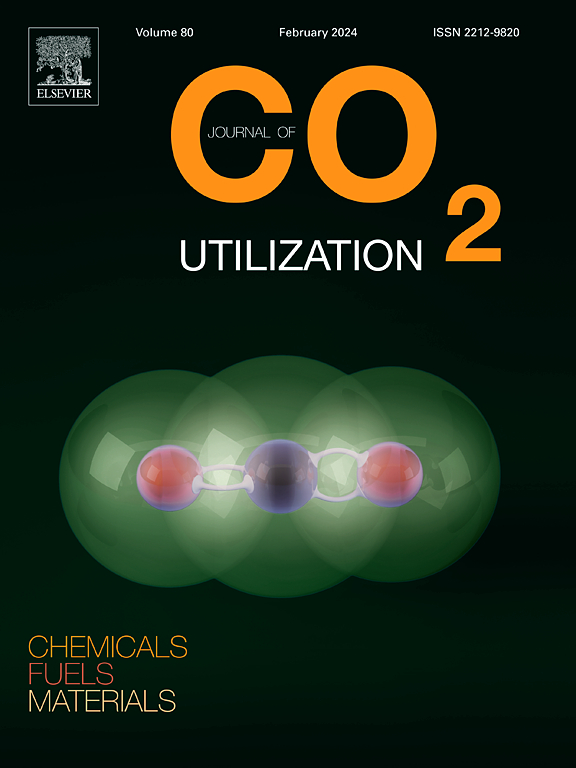CO2 as an alternative carbon source for ethanol production: A simulation-based technical and environmental analysis
IF 7.2
2区 工程技术
Q1 CHEMISTRY, MULTIDISCIPLINARY
引用次数: 0
Abstract
Three ethanol production scenarios from CO2 are analyzed: (S1) syngas catalytic conversion; (S2) syngas fermentation; and (S3) bio-conversion of CO₂ with H₂. These three scenarios were simulated in ProSimPlus® software, using flue gas from cement production and biogas as CO2 sources. Technological performance and environmental impacts evaluated through the Life Cycle Assessment (LCA) method were analyzed. Chemical absorption (CA) and membrane separation (MS) are utilized for carbon capture, while hydrogen is generated by electrolysis. When considering flue gas and CA, scenario S1_CA yielded the lowest ethanol production (0.110 kg/kg-CO2) but the highest energy consumption: 130 MJ electricity/kg-ethanol and 73 MJ heat/kg ethanol. Contrarily, S3_CA achieved the highest ethanol production (0.345 kg/kg-CO2) with energy consumption comparable to S2 (86 MJ electricity/kg-ethanol and 20 MJ heat/kg-ethanol). S1 demonstrated the lowest global warming impact (GWP100) with values of –8.60 kg CO₂-eq per kg ethanol for CA (S1_CA) and –10.13 kg CO₂-eq for MS (S1_MS). S1 outperformed both S2 (CA: 0.13 kg CO₂-eq, MS: –0.83 kg CO₂-eq) and S3 (CA: –0.43 kg CO₂-eq, MS: –1.00 kg CO₂-eq). When biogas was used, S3_CA exhibited the lowest impact: 3.00 kg CO₂-eq, compared to S2_CA: 6.36 kg CO₂-eq and S1_CA: 4.10 kg CO₂-eq. S1_MS and S3_MS have close results: 2.34 and 2.44 kg CO₂-eq, respectively, much lower than S2_MS (5.22 kg CO₂-eq). When considering the end-of-life with ethanol combustion, GWP100 results of flue gas-based scenarios become similar (S1) or worse (S2, S3) than current crop/vegetable fermentation production routes, while biogas-based scenarios strongly depend on fugitive emissions control.
二氧化碳作为乙醇生产的替代碳源:基于模拟的技术和环境分析
分析了三种二氧化碳制乙醇方案:(1)合成气催化转化;(S2)合成气发酵;(3) CO₂与H₂的生物转化。在ProSimPlus®软件中模拟了这三种情况,使用水泥生产产生的烟气和沼气作为二氧化碳源。分析了采用生命周期评价(LCA)方法评价的技术性能和环境影响。碳捕获利用化学吸收(CA)和膜分离(MS),而氢是通过电解产生的。当考虑烟气和CA时,情景S1_CA产生的乙醇产量最低(0.110 kg/kg- co2),但能耗最高:130 MJ电/kg-乙醇和73 MJ热/kg乙醇。相反,S3_CA的乙醇产量最高(0.345 kg/kg- co2),能耗与S2相当(86 MJ电/kg-乙醇和20 MJ热/kg-乙醇)。S1表现出最低的全球变暖影响(GWP100), CA (s3_ca)的值为-8.60 kg CO₂-eq / kg乙醇,MS (s3_ms)的值为-10.13 kg CO₂-eq。S1的表现优于S2 (CA: 0.13 kg CO₂-eq, MS: -0.83 kg CO₂-eq)和S3 (CA: -0.43 kg CO₂-eq, MS: -1.00 kg CO₂-eq)。当使用沼气时,S3_CA的影响最小,为3.00 kg CO₂-eq,而S2_CA为6.36 kg CO₂-eq, S3_CA为4.10 kg CO₂-eq。S3_MS和S3_MS的结果相近,分别为2.34和2.44 kg CO₂-eq,远低于S2_MS(5.22 kg CO₂-eq)。当考虑到乙醇燃烧的寿命终止时,基于烟气的情景的GWP100结果与当前的作物/蔬菜发酵生产路线相似(S1)或更差(S2, S3),而基于沼气的情景强烈依赖于无组织排放控制。
本文章由计算机程序翻译,如有差异,请以英文原文为准。
求助全文
约1分钟内获得全文
求助全文
来源期刊

Journal of CO2 Utilization
CHEMISTRY, MULTIDISCIPLINARY-ENGINEERING, CHEMICAL
CiteScore
13.90
自引率
10.40%
发文量
406
审稿时长
2.8 months
期刊介绍:
The Journal of CO2 Utilization offers a single, multi-disciplinary, scholarly platform for the exchange of novel research in the field of CO2 re-use for scientists and engineers in chemicals, fuels and materials.
The emphasis is on the dissemination of leading-edge research from basic science to the development of new processes, technologies and applications.
The Journal of CO2 Utilization publishes original peer-reviewed research papers, reviews, and short communications, including experimental and theoretical work, and analytical models and simulations.
 求助内容:
求助内容: 应助结果提醒方式:
应助结果提醒方式:


